Solving Cinchiness
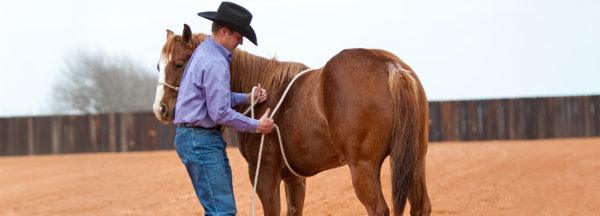
Is your horse grouchy or just downright dangerous when you tighten the cinch? Are you getting ready to saddle a young horse for the first time? In this Q&A article, Clinton explains what makes a horse cinchy and shares his No Worries approach to safe saddling.
What is a “cinchy” horse?
A “cinchy” or “cold-backed” horse has a tendency to overreact and possibly buck when pressure is applied around his belly or flank area. It’s normal for a horse to feel reactive whenever this area is squeezed tightly. Horses hate tight, narrow spaces or feeling claustrophobic, so when you wrap a rope or girth around a horse’s belly and pull it tight, it can make the horse feel trapped and uncomfortable. Horses are also protective of their belly because they don’t have a lot of muscle or tissue there to protect their abdomen and organs. If a lion attacked a horse, for example, and the lion got even one claw dug into the horse’s abdominal muscles, the horse could potentially end up with a life-threatening infection even if he escaped. It’s a part of horses’ self-preservation instinct to be very protective of their bellies, their hocks and legs down to their hooves, and from their ears forward.
What are some signs of a cinchy horse?
Look for behavior that tells you your horse feels uncomfortable with the girth around his belly. The most obvious sign is when a horse bucks with the saddle after having been cinched up. After he warms up a little and gets used to the girth’s tightness, he’ll relax. Cinchy horses will also pull back or set back when you tighten the girth, won’t stand still, and may keep walking around you in a circle when you try to tighten the girth. Another common sign of a cinchy horse is if the horse pins his ears when you tighten the girth.
Is cinchiness a sign of a bad-minded or a sour horse?
Not necessarily, but horses can become resentful and bad-minded about it. Imagine that first thing every morning when you get out of bed you have to put on a belt that’s really tight. That probably won’t put you in a good mood. If you had to do it morning after morning, you might turn into a real grump to be around. One the other hand, if you had a belt that fit, you could adjust it throughout the day depending on how you were feeling and what kind of shape you were in. Cinching up a horse really isn’t much different.
Could it be my fault that my horse is cinchy? Can cinchiness be caused by cinching my horse too tightly, poor saddle fit, or other reasons?
Although most cinchy or cold-backed horses have a natural tendency to be that way, this tendency can be greatly aggravated by human beings. Here’s how to avoid some of the most common causes of cinchiness.
Don’t Tie Your Horse
A common mistake I see people make is tying their horses when they saddle up. Whenever you tie a horse up, you’ve taken away his ability to move his feet or flee from danger. Then, if he gets scared or reactive, in his mind the only thing he can do to escape is to pull back and try to break free from the halter and lead rope. The extra pressure of being tied and getting cinched up can overwhelm more sensitive horses.
If you tie up a cinchy or young, green-broke horse when saddling, if he spooks or the saddle slips under his belly you’re going to have a big problem where not only could the horse potentially hurt himself, but now getting saddled will become a major source of fear.
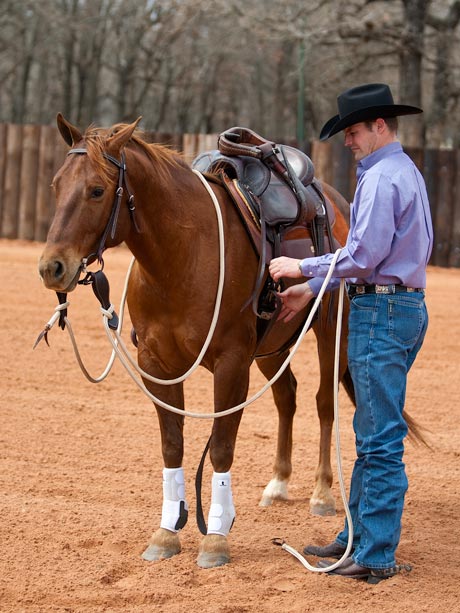
Instead of tying your horse up, practice saddling him with the lead rope draped over your arm as I’m doing here. This way, if the cinch makes him feel claustrophobic, he won’t feel as trapped because he knows he can move his feet. If he goes to move away, it’s easy to just reach over and grab the lead rope.
If your horse has a history of cinchiness, or you’re saddling a young horse, take the time to get him used to saddling with the following process:
- Saddle your horse in the round pen while holding his lead rope.
- Once he’s standing still while being saddled in the round pen (without any problems and without moving his feet), move him to an open area and saddle him while holding his lead rope.
- When he’s standing well in the open, dally the lead rope around a post (or use an Aussie Tie Ring) so that if he pulls back, it will give and he won’t feel trapped.
- If he stands well and doesn’t pull back in the open, repeat the process in the barn, first holding his lead rope until he stands quietly, then dallying the lead or using the Aussie Tie Ring in the barn.
Check saddle fit
Poor saddle fit can also lead to cinchiness. To determine if your saddle is causing your horse to be uncomfortable or cinchy, switch saddles for a week or two. If your horse’s behavior improves, you’ll know that the cinchiness was probably being caused by poor saddle fit. Having a good-fitting saddle and a quality pad really makes a difference in your horse’s performance and attitude.
Prep your horse for saddling
The biggest mistake I see people make, and one that tends to create a cinchy horse, often happens the first time a colt is cinched up. If his owner tightens the girth too tight and too soon, it frightens the horse and makes him really uncomfortable.
Because he’s not used to having anything on his back, a tight cinch makes the new experience of being saddled even scarier for him and often, this causes him to overact and buck. Then the owner usually makes the second biggest mistake — he takes the saddle off.
When I saddle a 2-year-old for the first time, I saddle him at 6 a.m. and keep him saddled all day. By letting the horse wear the saddle all day, I give him a chance to get over being scared, and usually by the end of the day he’s relaxed and has gotten past his initial reactivity.
If, on the other hand, he’s still bucking at the end of the day, I’ll keep him saddled all night as well. It’s very, very important to not take the saddle off until the horse has quit trying to buck or rub it off on the fence, roll on it, etc. For a horse to really accept a saddle, he has to think it’s part of his body, no different than his mane and tail.
How tight should I cinch my horse? How can I tell if my cinch is too tight?
While, there’s no golden rule for how tight you should cinch your horse, remember that you should tighten it in stages. The first time, I cinch the horse snugly but I don’t cut him in half. I want to give him a chance to warm up and get comfortable before I really cinch him up. I’ll do groundwork for about five minutes, and then I’ll check the girth and tighten it a little more. I’ll do groundwork again for five to 10 more minutes, and then I’ll tighten my girth for the third time.
This time, I really do it up tight. You may have heard me tell a joke about this at my tours. I often say that when I tighten a girth up, I tighten it so tight the horse’s eyes roll back in his head! Even though that’s obviously a joke, I really do make it a point to have my horse’s girths very snug.
When my horse is warmed up and mentally ready, I’m not afraid to cinch him up tight. The reality is most people don’t tighten their horse’s cinch up nearly enough. This isn’t just careless — it’s dangerous. When a saddle slips under a horse’s belly, whoever’s riding him is going to end up in a massive wreck.
If you ride your horse for longer than an hour, he’ll more than likely need to have his girth tightened again. Horse’s draw up after having been ridden a couple hours, so if you’re out trail riding you may need to readjust the cinch two or three times.
As a general rule, I’d rather have my horse’s cinch too tight than too loose. Some people worry that they’ll hurt their horse if they cinch them too tight. However, if you’ve warmed your horse up and given him time to get used to the saddle before really cinching him tight, you should be able to cinch him quite snugly without making him uncomfortable. Most people aren’t strong enough to cinch their horse too tight, so it’s not really something to worry about. If you do manage to cinch your horse too tight, you’ll know it. It will be obvious that the tightness of the girth is making him physically uncomfortable.
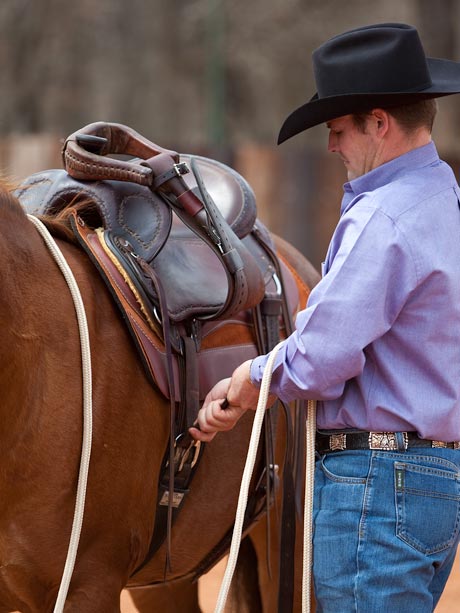
I always tighten my cinch in stages. First, I get it just snug. Then, after five minutes or so of groundwork, I tighten it again. Then, after another five or ten minutes of groundwork — right before I get on — I get it really tight. After you ride for an hour or so, you’ll most likely need to tighten it again.
Is it true that cinchiness points to a sore horse or a horse that needs chiropractic work?
Possibly. Some cinchy horses aren’t truly cinchy — they need chiropractic work to relieve pain or discomfort. However, in my experience, most horses are cinchy not because of a physical reason, but because they feel trapped and claustrophobic. They’re worried about the saddle, girth, and the flank girth. Once you get a horse over that fear and he stops using the reactive side of his brain, you normally won’t have trouble with cinchiness.
How can I prevent my horse from becoming cinchy?
The most important thing you can do to prevent cinchiness is to make sure you don’t have a wreck when you’re first saddling a 2-year-old. The last thing you want is to have the horse buck and get the saddle off his back or for it to slide underneath his belly. Not only will you ruin your saddle, but you’ll scare the horse half to death! When I saddle a young horse, I want it to go like clockwork and avoid any potential problems.
When saddling a colt, be sure to do some groundwork first to get him using the thinking side of his brain. Once you saddle him, cinch him up tight enough to keep the saddle on even if he really bucks with it. After your colt’s saddled, leave the saddle on for several hours, or until he’s completely calm and no longer worried about it. The worst thing you can do with a 2-year-old is saddle him for an hour or two, then take the saddle off while he’s still worried or uncomfortable being saddled. If you take the saddle off too early, he’ll think that bucking or rolling with the saddle is the way to get rid of it. I don’t ever take the saddle off a colt until he completely ignores it and has forgotten it’s even there.
How can I stop my horse from being cinchy?
First, work through the exercises from my DVD series, Gaining Respect and Control on the Ground I and II, to get your horse using the thinking side of his brain and to increase his respect. Then, use my Approach-and-Retreat Method — first with a rope, then with the saddle.
Squeeze and release
To desensitize your horse to the feel of a cinch, start by throwing a lead rope over his back and pull it up underneath his belly. Tighten it like you would the girth using my Approach-and-Retreat Method: approach and tighten the rope around the horse’s girth, and when he stands still and relaxes, release the rope and retreat. Then, approach again, pull it up tight, and as soon as the horse relaxes, loosen the rope and retreat.
Repeat this exercise, squeezing the rope tight, then releasing it, until you work up to the point where the rope is as tight you can make it, and your horse just stands there and ignores you. Perform this exercise where both your front and back cinch would be. (Remember, as you get toward the back cinch area to have the horse’s nose tipped toward you in case he tries to kick or overreact so you can quickly turn his hindquarters away from you.)
Performing the desensitizing exercise with the rope in between each of the groundwork exercises from Gaining Respect and Control on the Ground, before you saddle the horse, can make a big difference in how he reacts to both you and the saddle.
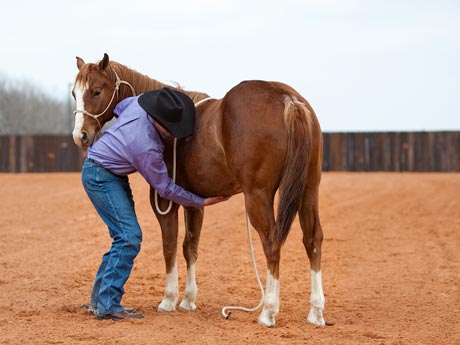
An exercise that I’ll use to fix cinchiness is to use my lead rope to desensitize his girth area and belly. First, I’ll toss the rope around the horse’s belly and then rub his belly where the cinch will go.
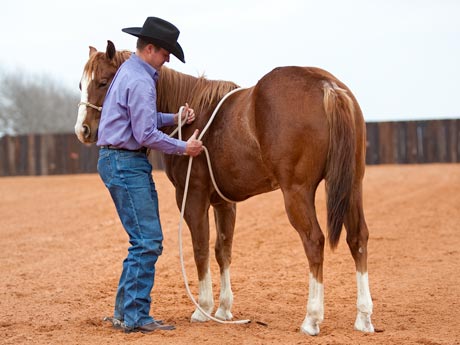
Next, I pull the top part of the rope down and the bottom up to tighten the rope around his belly, then wait for the horse to relax. As soon as he stands still and relaxes, I release the pressure.
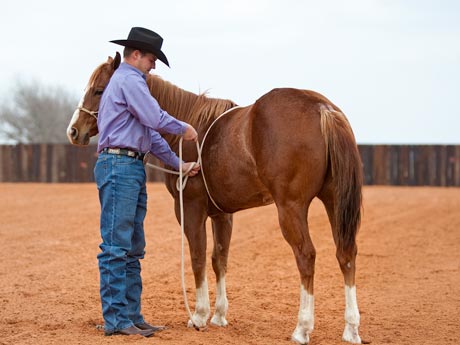
Each time I pull up on the rope, I pull it a little tighter until I can pull as tight as I can and the horse still just stands there relaxed.
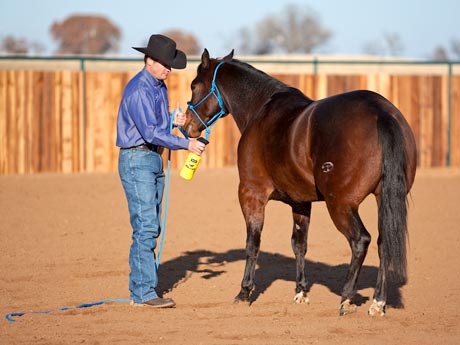
As soon as my horse is comfortable with the rope being tight around his girth area, I’ll start moving the rope in a seesaw motion up and down his belly, all the way back to his flank, tightening and releasing as I go. I’ll keep doing this until he stands still and relaxes, even with the rope tight around his flank.
Saddle Right
When your horse is calm with the Squeeze-and-Release rope exercise, you can move on to saddling. Don’t saddle him first thing in the morning when he might be fresh or full of beans and using the reactive side of his brain. Instead, get him using the thinking side of his brain first. Again, remember: until your horse stands like a rock when being saddled out in the open or in the round pen, don’t tie him up when you saddle him.
When you saddle the horse after doing groundwork, mirror the work you did with the rope. Pick up the front cinch and pull it up kind of snug, then release it a few inches; pull it up snug, then release it. This lets your horse know what’s coming, so you don’t just walk up to him, and jerk the girth up tight. I’ll continue pulling the cinch up snug and releasing it until the horse accepts it and is totally relaxed.
If your horse starts to buck with the saddle when you lead him off, give him something else to do by redirecting his feet and engaging the thinking side of his brain. Don’t let him get in the habit of bucking around the round pen with the saddle, but instead keep making him change directions by performing my Lunging for Respect exercises, Stage I and II. To make a horse quit bucking, just keep redirecting those feet! Eventually, the horse will decide that it’s not worth his time to buck. By constantly redirecting his feet, you’re making the right thing easy and the wrong thing difficult.
When dealing with a cinchy horse, keep in mind that most cinchiness can be prevented if you take the time to look at it from the horse’s point of view. Desensitize the horse, give him time to get used to the saddle, and cinch him up three separate times before getting on.
By giving your horse a chance to get along and get used to the saddle, you’ll both have a better and more rewarding relationship.
Want To Learn More? SIGN UP FOR OUR LOYALTY PROGRAM
Master your horsemanship training through Clinton’s step-by-step method videos by joining the No Worries Club today. Becoming a club member ensures you get VIP pricing on all of Clinton’s must-have training tools and resources. Plus, you’ll enjoy all the phenomenal benefits that come with club membership!


